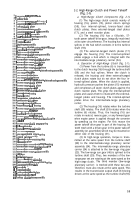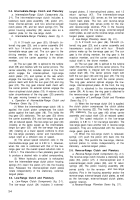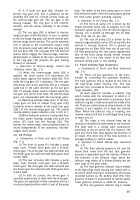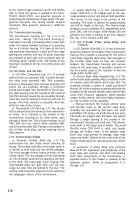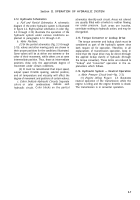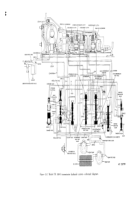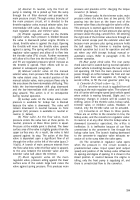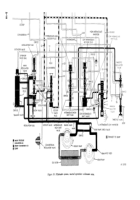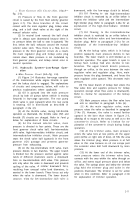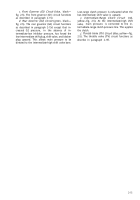TM-9-2520-254-34 - Page 22 of 126
b. Converter-In Circuit (yellow—fig.
2-4).
(1) The converter-in circuit functions as
described in paragraph 2-14b, except for two
conditions shown in figure 2-4 which differ from
those shown in figure 2-3. In lockup operation, the
flow of oil to converter-in line must pass through
the orifice near the left side of the lockup valve.
Also, the converter-in regulator valve is shown in an
open position, allowing excess oil to return to the
transmission sump.
(2) In lockup operation, the torque converter
does not require a flow of oil as great as that
required during converter operation, hence the oil is
directed through an orifice. When the flow to the
converter is reduced, the converter-in regulator
valve may open to discharge excess oil and limit the
pressure in the converter-in circuit.
c. Front Governor (Gl) Circuit
(blue, black—
fig. 2-4).
(1) In low-range operation, the G1 circuit is
operative (para 2-14c (1)).
(2) Pressure is prevented from bleeding off
past the ball check valve at the right of the manual
selector valve. When governor pressure is sufficient
to overcome spring pressure (plus throttle (T)
pressure) above the lockup valve, it will force the
lockup valve plug and valve upward. This will
charge the lockup feed line.
(3) At the main pressure regulator plug,
pressure is exerted against the lower surface area of
the plug. This tends to raise the plug. But, when the
lockup valve is upward, main pressure above the
plug keeps it from moving. When the lockup valve
is downward (converter operation), the regulator
plug moves upward to reduce main pressure as
governor pressure rises. The orifice in the governor
pressure line restricts flow to prevent movement of
the plug being too rapid when it does move.
d. Rear Governor (G2) Circuit
(green, black-
fig. 2-4).
(1) Rear governor (G2) pressure is produced
by the rear fluid velocity-type governor (para 2-2).
This pressure is directed to four points and is the
primary control force for all automatic upshifts and
downshifts between ranges.
(2) G2 pressure is directed to the lower surface
areas of the low-intermediate blocker plug and the
low-intermediate shift plug. This produces an
upward force at each plug. The low-intermediate
blocker plug is shown in its downward position,
being unable to move against its spring and
inhibitor pressure. The shift plug (and shift valve)
are shown in their downward positions. They have
not moved upward, in this instance, because
throttle (T) pressure, spring pressure, and inhibitor
pressure is sufficient to prevent upshift.
(3) G2 pressure is directed also to the lower
surface areas of the intermediate-high blocker plug
and the intermediate-high shift plug. This produces
an upward force at each plug. These plugs and the
intermediate-high shift valve are prevented from
rising by spring pressure, inhibitor pressure, and
throttle (T) pressure opposing their movement.
e.
Low-Range Clutch Circuit
(red, black—fig.
2-4). The low-range clutch circuit directs oil to the
low-range clutch when the low-intermediate shift
valve is downward. When the shift valve is upward,
the low-range clutch exhausts through a port at the
right side of the low-intermediate shift valve bore.
f. Throttle Valve (TV) Circuit (blue,
yellow—fig.
2-4).
(1) Throttle valve (TV) pressure originates at
the throttle regulator valve when the throttle is
initially opened.
It increases as the throttle is
opened farther. This pressure is directed to areas
near the upper ends of the low-intermediate and
intermediate-high shift valves, to
the main
pressure modulating plug, and to the extender
valve.
(2) At the low-intermediate and intermediate.
high shift valves, TV pressure exerts a downward
force which retards upshifting. Thus, the more the
vehicle engine throttle is opened, the later up-
shifting occurs. When the valves have upshifted,
TV pressure is blocked.
(3) At the main regulator modulating plug,
downward pressure increases main pressure by
moving the main regulator valve downward. Thus,
as throttle opening progresses, main pressure is
boosted.
(4) At the extender valve, TV pressure tends to
push the extender valve downward. In figure 2-4,
the valve is upward because both spring pressure
and main pressure oppose downward movement.
The effect of downward movement is an increase in
pressure required beneath the extender valve ball to
unseat it. This action influences trimmer operation
(para 2-16i).
(5) TV pressure actually connects into the
throttle (T) pressure circuit while either the low-
intermediate shift valve or the intermediate-high
shift valve is downward. This connection occurs in
the valve bore areas near the upper ends of the
valves. Thus, there is pressure in the T pressure
circuit prior to upward movement of the throttle
valve to a point which connects the TV and T
circuits.
This pressure retards the upward
movement of the lockup valve and delays lockup.
However,
when the low-intermediate and in-
termediate-high shift valves are both upward,
there can be no connection of the two circuits
except at the throttle valve.
g. Throttle (T) Pressure Circuit
(green, yellow—
fig. 2-4).
(1) At approximately
5
/
8
inch of throttle
opening (upward movement of throttle valve),
2-13
Back to Top

